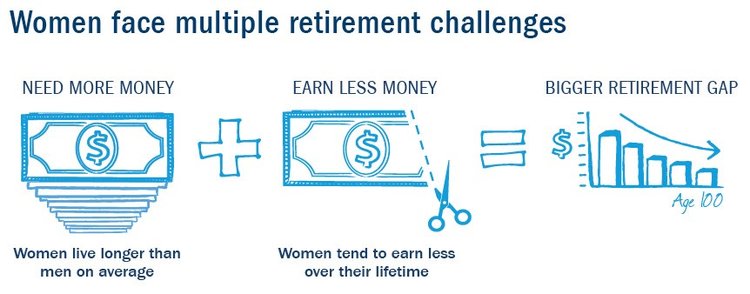
For many people, retirement is a top financial goal. But for women, it’s particularly important to face the numbers and get invested.
1. Women are living longer. So their retirement savings needs to last.
People are living longer than ever before — women even more so. Today, the average life expectancy for U.S. women is 81.1 years versus 76.1 years for men.(1) In fact, among Americans age 85 and older, women outnumber men by a 2 to 1 ratio.(2) Living longer also means funding retirement for an extra five years. What’s more, this will likely mean higher health care expenses. A 65-year-old woman today can expect to spend 18% more on health care expenses in retirement compared with a man the same age, due in part to their longer life expectancy.(3)
2. Lifetime earnings tend to be lower for women, making it harder to save enough for retirement.
Women still make only about 80.5 cents for every dollar a man makes in a similar job.(4) What’s more, women are more likely to take time out from work to raise children or care for other family members. These challenges add up: Smaller paychecks compounded with fewer years in the workforce means less money to set aside for retirement.
Even those fortunate enough to have a defined-benefit pension plan at work may receive lower benefit payments too. Pension benefits tend to be based on earnings and tenure, so if a woman makes less or works fewer years, the company pension will pay less in retirement.
3. Social Security does not provide a comfortable standard of living, and average benefits are lower for women.
Some women may plan to make up for their retirement savings deficits with their Social Security benefits. But the estimated average Social Security benefit is just over $16K per year. While that may sound low, consider that the average woman receives even less than that.
That maximum benefit is calculated on a worker’s highest earnings over 35 years. So again, if a woman earns less than a man and if she takes time out from the workforce, the Social Security benefit may very well be smaller than the maximum payout. It will likely be smaller than what many men receive. That explains why the average Social Security retired worker benefit for women is $14,928 per year, compared with $18,780 for men.(5)
So how do women face the retirement challenge?
What can women do to address these challenges? One solution is to continue working longer and retire later. Unfortunately, research has shown that this plan isn’t always possible. In a recent survey, 48% of retirees reported retiring earlier than planned, and a majority of those were not by choice, but because of health problems, disability or loss of employment.(6)
There’s no getting around the need to grow a significant nest egg to fund retirement. We always hear about “saving for retirement,” but the truth is that saving — simply accumulating cash in a savings or money market account — isn’t enough. Cash will lose purchasing power over time. That’s why it’s important to invest to build wealth. And although investments like stocks and bonds carry some risks, they also have the potential to provide income and grow in value.
Bottom line
It’s more important than ever for women to get invested. Some of these statistics may feel overwhelming, but they’re not meant to intimidate. If you’re a woman investor (or want to be), facing the numbers and knowing the facts can very well be the motivation you need to take a more active role in your financial future.
———————————————–
Sources
1 National Center for Health Statistics, Data Brief No. 328, November 2018.
2 U.S. Census Bureau, Facts for Features, Women’s History Month, March 2018.
3 HealthView Services, “The High Cost of Living Longer: Women & Retirement Health Care,” 2017.
4 U.S. Census Bureau, “Income, Poverty and Health Insurance Coverage in the United States: 2017,” September 2018.
5 Social Security Administration, “Fast Facts and Figures about Social Security 2018.”
6 Employee Benefit Research Institute, “2018 RCS Fact Sheet #2: Expectations About Retirement,” 2018.
